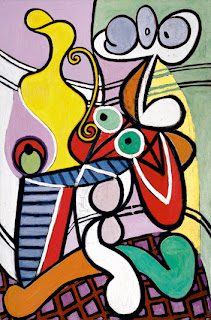

Along the way, it is up to us to make pivotal observations, judgments, and decisions. The piece is architectural to the highest degree, and forces the viewer to actively work to distinguish the subject. Picasso uses charcoal here to its broadest range and capability, employing hatching, deep lines, elegant shading and distinct areas of light and shadow. Standing Female Nude - Pablo Picasso (1910, Charcoal on paper) With this drawing, Picasso succeeded in creating the impression of mechanized movement while almost totally obscuring his subject. The woman appears through a cage-like structure, the most essential aspects of her form crossed out and yet she seems to move freely and fluidly, coiled and ready to jump or take flight. A mere gesture of the subject’s natural curves remains her arm is reduced to an almost illusory ribbon, and her basic shape, once identified, is transformed, doubled, and syncopated. When first shown in America, the piece created a stir because of its highly abstract nature: the human form is almost lost in a construction of ladder-like steps and harsh lines. In 1910, Picasso produced an interesting addition to his existing charcoal oeuvre: Standing Female Nude, a smaller work that helped pave the way for the advent of Analytic Cubism. He produced works that drastically altered existing artistic traditions, and did so with a seeming effortlessness, despite many years of poverty and hardship. From childhood, he embodied artistic genius and worked along a highly accelerated trajectory, ultimately changing the accepted face of art at a very young age. This article has been edited and updated.Pablo Picasso (1881-1973), perhaps the most famous and gifted artist ever to grace the world stage, was a child prodigy instructed in drawing and painting by his father from the age of seven. There were three primary phases of Cubism: Proto-Cubism, Analytical Cubism, and Synthetic Cubism.

What are three different styles of Cubism? From Cubist tattoos to graffiti inspired by Picasso's portraits, these playful pieces showcase the timeless aesthetic, captivating compositions, and lasting legacy of Cubism.Ĭubism is an art movement pioneered by Pablo Picasso and Georges Braque, characterized by fragmented subject matter deconstructed in such a way that it can be viewed from multiple angles simultaneously.Ĭubist art features a single viewpoint, emphasis on overlapping geometric forms, fragmented subjects, and rejection of traditional techniques, such as modeling. In addition to these modern genres, Cubism's influence is also evident in contemporary art. 2,” 1912 (Photo: Philadelphia Museum of Art via Wikimedia Commons) Marcel Duchamp (Dadaist), “Nude Descending a Staircase No. Scientific perspective forces the objects in a picture to disappear away from the beholder instead of bringing them within his reach as painting should.” “Cézanne, and after him Picasso and myself, can take a lot of credit for this. “The hard-and-fast rules of perspective which it succeeded in imposing on art were a ghastly mistake which it has taken four centuries to redress,” Braque explained to The Observer in 1957. These include flat planes of color, geometric forms, and, most significantly, a distorted sense of perspective. Given the popularity of Post-Impressionism and Braque's own relationship with Fauvism, it is no surprise that both movements played a pivotal role in shaping Cubism.Ĭubists borrowed several artistic elements employed by Post-Impressionist painters-namely, Paul Cézanne. Due to his emphasis on color and simplified geometric shapes, he was integral to the development of the style.įamous works of art: Portrait of Picasso (1912)

His earlier works fit into Analytical Cubism, standing apart from Braque and Picasso for their distinctly vibrant color palette-a trait that was partially inspired by the colors of Matisse's paintings. Spanish-born artist Juan Gris was another integral member of the Cubist art movement. Juan Gris, “Still Life Before an Open Window, Plane Ravignan,” 1915 (Photo: Wikimedia Commons, Public domain)


 0 kommentar(er)
0 kommentar(er)
